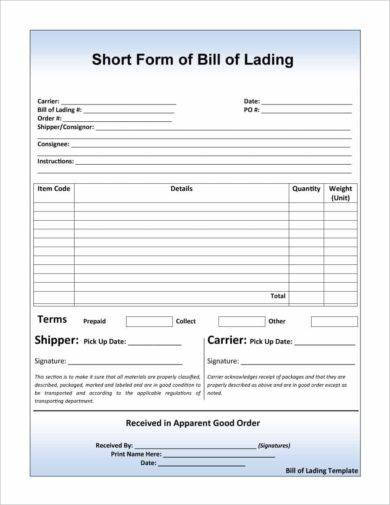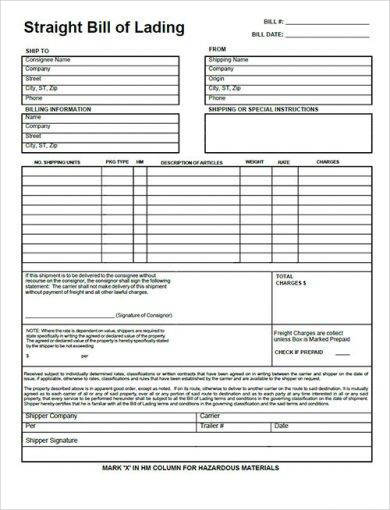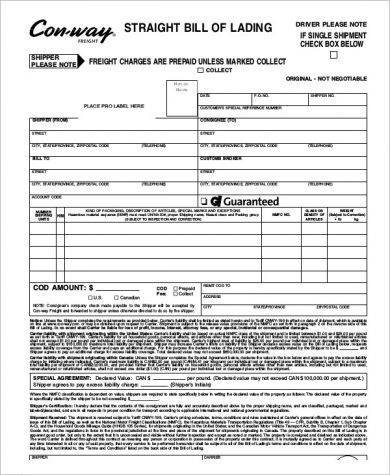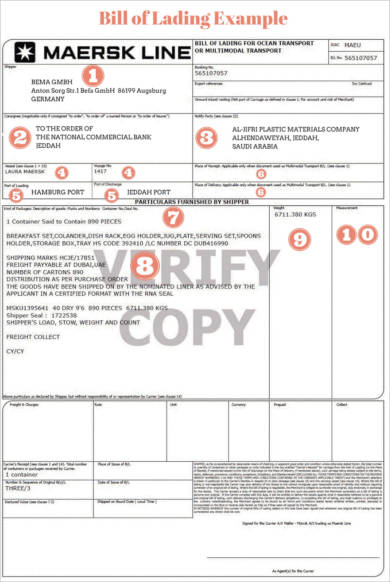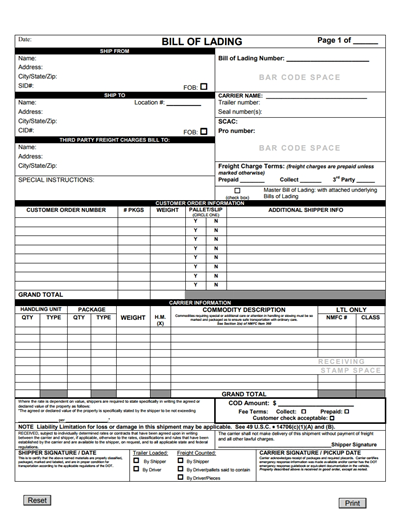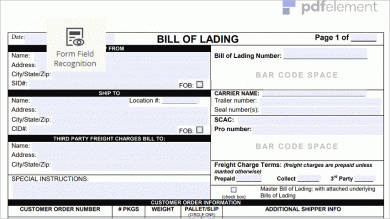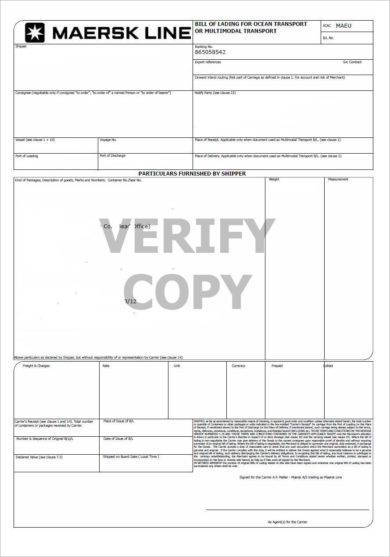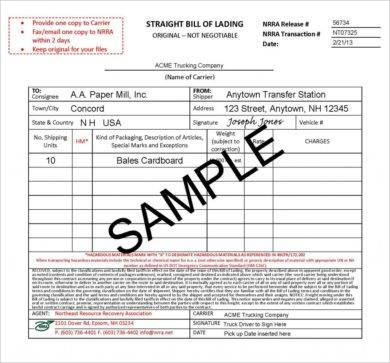8+ Straight Bill of Lading Examples to Download
A straight bill of lading is a legally required document that the parties involved must complete before a shipment can be allowed to deliver its goods. It serves as a protection for both the carrier and the shipper since it contains a detailed description of the exact weight of the shipment, its exact value, its type, the quantity, and destination of the materials being transported. The carrier will be the one to issue the document that he will have to submit to the shipper of the goods.
The bill of lading is known to play three important roles. First, it serves as a general receipt since, as aforementioned, it dictates an account of the goods being shipped and, being legally issued, it’s a generally trusted document. It will serve as a proof that the shipper indeed received the cargo from the carrier in apparent good condition.
Second, it serves as an evidence of the contract and the transaction that took place between the carrier and the shipper in relation to the goods being transported as agreed by the original buyer and seller.
Lastly, a straight bill of lading serves as a document of title, which means that the freight can be legally transferred to the person holding the bill of lading which, in most cases, is the shipper of the goods. He now has the right to claim the goods so that he can transfer it to the other party involved in the transaction. You may also see bill receipt examples.
Straight Bill of Lading Example
Short Form of Bill of Lading
Bill of Lading vs. Freight Bill
Most people confuse these two very similar documents; however, it is important that their unique roles are understood. A bill of lading is a legal document that gives an explicit account of when, how, and where the items will be transferred. It is a valid representation of the agreement between the shipper and the carrier regarding the important details of the shipment.
It’s often the reference that the parties involved rely on to tell them if the company has successfully reached their obligations. Because of this, the accuracy and exactness of the document is of paramount importance since a single error can lead to a serious legal battle. You may also see restaurant receipt examples.
Freight bills, on the other hand, are specially different since they cannot serve as an evidence or a reference should a misunderstanding arise between those involved. It’s simply a document that attempts to clarify the information already written on the simple bill of lading.
People refer to freight bills when they want to check the invoice for the freight auditing process. They play similar role to the invoices that regular business use. Although they may not be as important as its counterpart, freight bills must also be retained long-term since they may come in handy the same way that receipts do in business transactions. You may also like travel invoice examples.
Although equally different, the bill of lading and the freight bill work together for the same role. They both try to create a big, detailed picture of the between the entities involved in the shipment of the goods. The bill of lading will describe the relationship of the company, while the freight bill will describe the financial aspect of the transaction.
When studied alongside each other, both documents will provide information on the total cost of the shipment and the circumstances when the payment will be acquired.
Information That Should Be Included on the Bill of Lading
Accuracy is the main professional goal of every bill of lading. All the vital information must be included in the document to assure that there will be no discrepancies in the transaction. In creating one, make sure that the following details are in the document:
- The complete names of the shipper and the receiver (consignee) and their exact addresses
- The date of the shipment
- The number of shipping units
- The classifications of the freight shipment
- The exact weight of the shipment per shipping unit
- The type of packaging used (carton, pallet, skid, or drums)
- A description of the item being shipped including the material used for manufacturing it
- The special account numbers used between the businesses for order tracking
- Any specific instructions to the carrier
- A note that states if the freight has been considered by the Department of Transportation a hazardous material, since there are certain rules and requirements that apply to these cases
- The declared value of the goods being shipped
Straight Bill of Lading Document
Straight Bill of Lading Template
Types of Bill of Lading
The types of bill of lading differs depending on the mode of transportation you use for the shipment, either by sea, air, truck, or railway.
1. Ocean Transportation
When goods are transported by ship, the document that will be issued is an ocean bill of lading. The Federal Maritime Commission is the agency that regulates any shipment that comes to or from the United States of America. There are different types of ocean bill of lading. Some of the common ones are:
- A straight bill of lading. This type is the one we have mainly discussed in our article. It is a non-negotiable bill of lading that is addressed directly to the buyer, with the buyer’s custom broker listed as “Notify Party.” This document is often issued especially for cases where the buyer still owes payment for the goods. You may also see service invoice examples.
- An order bill of lading. This is a negotiable form that is addressed “to order” instead of being directly consigned to the buyer. The carrier will have to hand over the shipment to whoever presents this document, who is assumed to be the owner of the goods being shipped. The order bill of lading is commonly used for cases wherein the purchase of the goods is covered by a letter of credit. You may also like hotel invoice examples.
- The electronic “telex” release. Having this document will eradicate the need for an original bill of lading to be presented at the destination of the shipment for the goods to be released. Instead, the shipper will endorse the bill of lading to the carrier’s agent at the origin of the shipment. The origin agent will then be tasked to notify the other agent at the destination that the goods may be received even without the original copy of the bill of lading. This document is often used for cases wherein the buyer still owes money for the goods, but then settles the bill before the cargo arrives. You may also check out billing invoice examples.
- An express bill of lading. This type of bill of lading can only be used for cases wherein the carrier agrees to only release the goods to the named consignee or to the notify party. It is non-negotiable, and no original bills of lading are issued at all. This document is best for expediting the release of the goods upon arrival. It helps save time and mail courier fees by eliminating the need for a physical bill of lading to be presented. However, the express bill of lading can only be used if the importer has paid for the goods before the shipping. You might be interested in purchase invoice examples.
Bill of Lading Example
Straight Bill of Lading Form Template
2. Air Transportation
Air waybills are issued when goods are transported by air. These documents are also non-negotiable, which means that once the cargo arrives at the designated airport, it will be immediately handed over to the consignee or the custom broker for custom clearance and final delivery. This document also serves as a general contract, a cargo receipt, and a delivery instruction.
However, if the goods to be shipped are under a letter of credit or the shipper is using a bank account to collect payment for the goods before they can be released to the consignee, the air waybill may be consigned to that bank. In this case, the consignee will pay the bank, and the latter will provide a release to the airline giving them the leave to release the goods. You may also see school receipt examples.
Unfortunately, this process will take at least several days. Until the operation can be finished, the goods will have to sit at the airline warehouses with additional storage charge.
3. Land Transportation Waybill
This type of bill of lading is more widely used in North America for overland shipments. In issuing one, you must first understand the limits and liabilities that may be involved with the movement of the shipment. This document is never negotiable. But it can be sent with the terms to “Collect on Delivery” where an additional fee will be paid to the carrier handling the goods. You may also like construction invoice examples.
4. Uniform Bill of Lading
This type of bill of lading is issued for overland shipments and, as its name suggests, is subjected to uniform terms and conditions such as transportation tariffs or contract carriage agreements. Also known as the waybill, this document may be consigned “to order” which turns it into a negotiable bill of lading, similar to that of the ocean bill of lading. It includes the entirety of the terms and conditions of the shipment. You may also check out simple invoice examples.
5. Hand Tag
This one is perhaps the most common of all the types of bill of lading. It’s typically used when a truck driver shows up at a shipping dock or a door for cargo pickup. There he will fill in a form by hand, which is where the process got its name. It’s a considerably shorter form of contract with a brief note instead of a lengthy terms and conditions written on it. You might be interested in medical invoice examples.
However, although it is, by far, more casual in nature, it is still covered by the carrier’s liability limit. It is also more convenient than the other bill of lading types, which is why it is frequently used in the air freight and local carriage services that are hired to pick up cargo from shippers. You may also see catering invoice examples.
How to Edit a Bill of Lading
Straight Bill of Lading for Ocean Transport
Consequences of Inaccurate Bill of Lading
As unfamiliar as the rest of the world may be on the importance of bills of lading, it is actually one of the most important documents in the shipping industry. It’s both binding and equally informative for both the shipper and the carrier. As we’ve already discussed earlier, accuracy in bills of lading is paramount. You may also see medical receipt examples.
Even the slightest mistake can open up complications and legal issues. Which is why the document must be completed and provided to the shipper when the goods are picked up. Otherwise:
1. With erroneous details, the shipment may not reach the desired recipient.
2. The parties involved may not have an accurate document to serve as a reference should they have a claim that needs to be defended since the details in the paper are inaccurate.
3. There may be people who will have to face the consequences of the defectiveness of the document.
4. The company may lose their right to limit liability for a claim if their cargo is damaged or inexact.
5. Protection and Indemnity insurance may no longer cover the claims in circumstances where the description of the goods in the bill of lading is found to be inaccurate. You may also like invoice examples in excel.
6. Worst case scenario, the company may be prosecuted for fraudulent activity.
Common Mistakes on the Bill of Lading
Committing errors are accepted as a normal human flaw. However, in business, it is a weakness that must be avoided at all costs since it can lead to serious problems for the company. Here are some of the common mistakes in completing a bill of lading:
1. Giving an unreliable description of the goods to be shipped. Each item, if possible, should be described with utmost precision to avoid unwanted complications and unnecessary problems from arising.
2. Miscalculation. Aside from counting the number of containers, you must also take absolute care when counting the number of goods in each one. This is only an extension of the first rule. Including the exact number is a characteristic of precise description. You may also check out receipt examples in pdf.
3. Not following all of the bank’s instructions when completing the letter credit for the bill of lading. For cases where a bank is concerned with the transaction, make sure that you follow their instructions carefully, and that all of your paperwork is consistent in each document. Otherwise, the bank may find good reason to deny your letter of credit. You might be interested in photography receipt examples.
4. Using the wrong “Notify Party”
5. Incorrectly identifying the hazardous materials requirements. Each shipment company must be fully aware of the rules and regulations involved in shipping goods with hazardous materials.
Original Straight Bill of Lading Sample
Remember that there are legal complications to creating an erroneous straight bill of lading, so refer to these examples and guidelines when creating your own to avoid having to face any legal issue.




